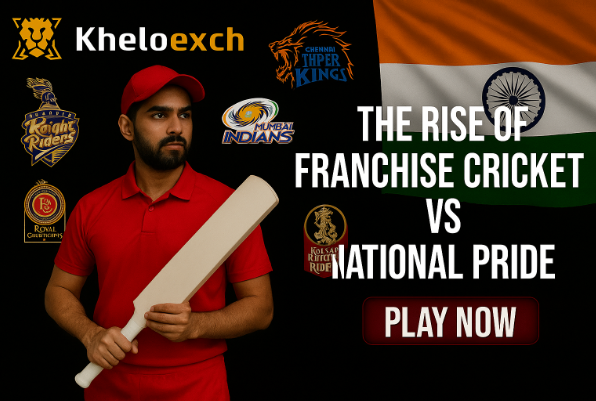The Rise of Franchise Cricket vs National Pride

Cricket has always been more than just a game—it is deeply tied to national identity, culture, and pride. For decades, the ultimate dream for any player was wearing the national jersey and representing their country at the highest stage. However, the last 15 years have witnessed a dramatic transformation in how the sport is played, consumed, and valued. The rise of franchise cricket has brought new opportunities, new money, and new fame—but it has also sparked debate about whether national cricket is being overshadowed.
The Birth of Franchise Cricket
The Indian Premier League (IPL), launched in 2008, revolutionized cricket. Its blend of entertainment, global stars, and high-paying contracts created a blueprint that other countries quickly adopted. Today, leagues like the Big Bash League (Australia), Pakistan Super League, SA20 (South Africa), and the Caribbean Premier League have become major attractions.
These leagues offer players not only substantial financial rewards but also worldwide exposure. Young cricketers now grow up dreaming of being bought at an auction just as much as representing their country.
Why Players Prefer Franchise Leagues
Several factors explain the growing preference for franchise cricket among modern players:
- Financial Security: A season in a major franchise league can sometimes earn a player more than a year of international contracts.
- Shorter Commitments: Compared to long tours with national teams, franchise seasons are compact and less physically draining.
- Global Exposure: Players share dressing rooms with legends, gaining invaluable experience.
- Brand Building: Franchise leagues often give players more visibility on social media and television.
This shift has created a new career path for cricketers—where league stardom can sometimes feel more rewarding than national duty.
The Emotional Weight of National Pride
Despite the rise of franchise cricket, the emotional pull of representing one’s country remains unmatched. For fans, nothing compares to the pride of singing the national anthem before a World Cup game or witnessing a Test match victory overseas.
Players, too, often speak about the honor of donning their national colors. Virat Kohli, Steve Smith, and Kane Williamson have all emphasized that franchise success is temporary, but international victories create legacies.
The debate, then, is not about choosing one over the other but finding balance.
The Clash of Schedules
One of the biggest challenges is the scheduling conflict between international fixtures and franchise leagues. For instance:
- West Indies cricketers often prioritize franchise leagues due to the financial disparity with their central contracts.
- South African players at times choose leagues like IPL or SA20 over national Test tours.
- Even established nations like England and Australia have had to rotate squads to manage overlapping commitments.
This has left cricket boards struggling to maintain a consistent pool of players for national duty.
The Fans’ Perspective
Fans are at the heart of this debate. Some embrace franchise leagues wholeheartedly because they bring excitement, new formats, and close finishes. Younger fans, in particular, are drawn to the glamour and star culture of leagues.
Yet, traditional fans argue that nothing can replace the passion of national rivalries—India vs Pakistan, Ashes series, or Australia vs South Africa in Tests. For them, leagues are entertainment, but national cricket is heritage.
Can Both Coexist?
The question is not whether franchise cricket will overtake national pride, but rather how both can coexist. Several suggestions have been floated:
- Dedicated Windows: The ICC and national boards could create clear windows for franchise leagues, minimizing overlap with international series.
- Player Contracts: Boards may need to increase central contracts to retain loyalty, ensuring players aren’t tempted to skip tours.
- Rotation Policies: Teams could strategically rotate players to allow participation in both formats.
Cricket’s future may lie in a hybrid model where franchise cricket fuels financial growth, while international cricket sustains cultural and emotional connections.
The Bigger Picture
Franchise cricket has undeniably globalized the game. Fans in America, the Middle East, and even Europe are now engaging with cricket thanks to these leagues. Players from associate nations like Nepal, UAE, and Namibia gain recognition through franchises, something national cricket alone couldn’t provide.
However, the ultimate test of cricket’s identity lies in whether the World Cup, Test series, and traditional rivalries continue to hold their historic value. If they do, national pride will always stand tall, no matter how glittering the world of franchise cricket becomes.
Conclusion
The rise of franchise cricket is not a threat—it’s an evolution. It offers players opportunities, brings fans entertainment, and grows the sport financially. But national cricket, rooted in pride and heritage, still carries unmatched emotional weight. For the game to thrive, both worlds must coexist harmoniously.
For fans who want to stay updated on cricket—whether it’s franchise clashes or international rivalries—platforms like Khelo Exchange provide insights, schedules, and updates. If you’re looking for seamless access on the go, Kheloexch99 App Download ensures you never miss a moment of the action.





